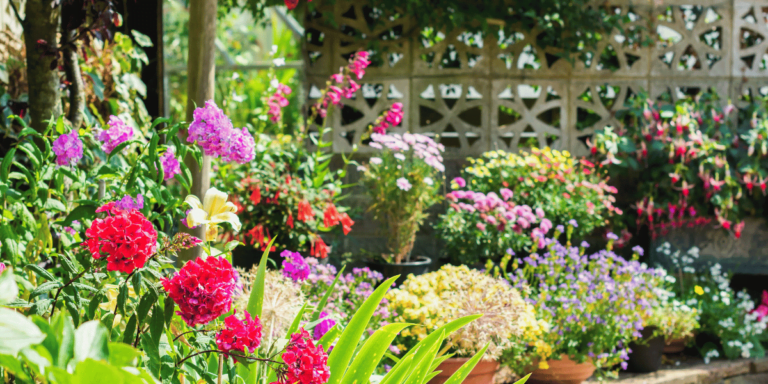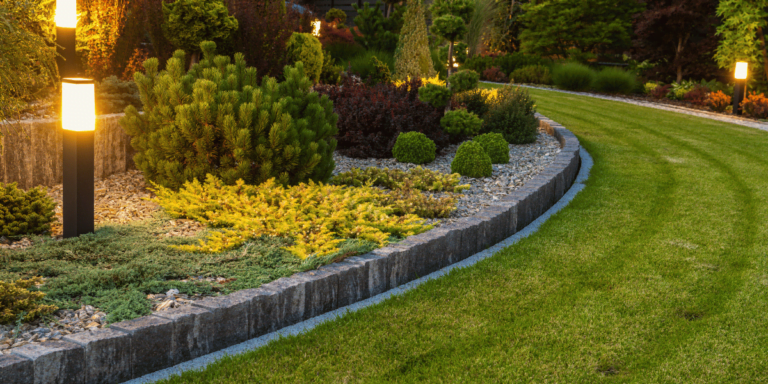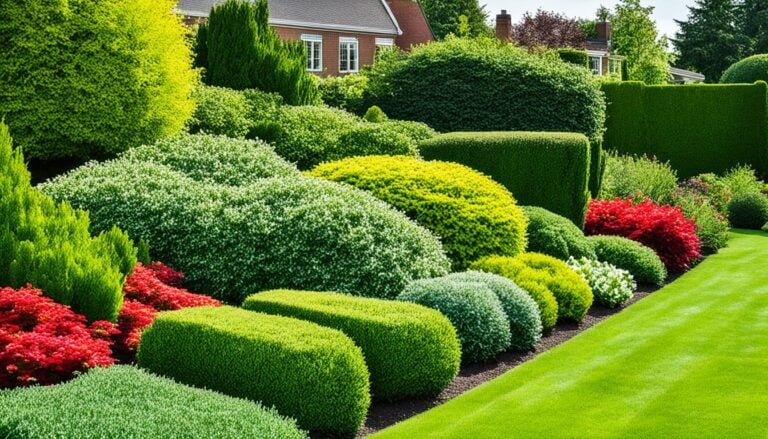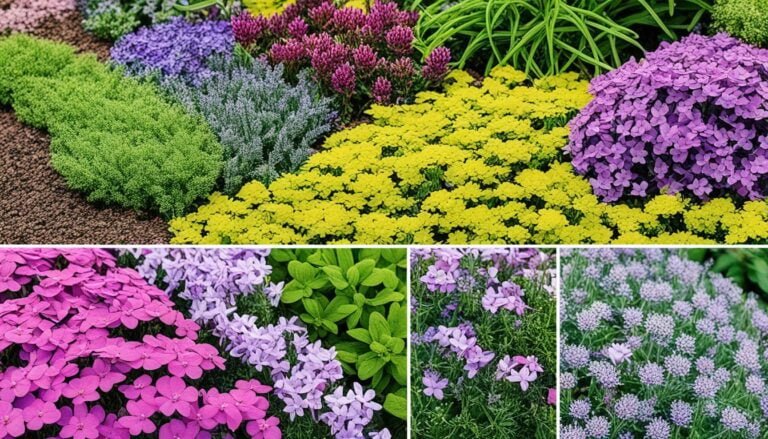Ground Covers Plants are key in a well-designed garden. They add color and texture, while also serving practical roles. These plants can stand in for grass in the shade, fill spaces between stones, or act like natural mulch. They cool the soil and cut down on weeds. So, they’re perfect for a garden that’s both beautiful and easy to care for.
There are many types of ground cover plants to choose from. They vary in hardiness, where they like to grow, and what they look like. When you pick the right ones, you can make your garden look better, with less work. They’re great for sunny areas, dark spaces, or even on slopes. You’ll find the perfect plant for your garden’s unique needs.
Key Takeaways
- Perennial ground covers plants offer both beauty and functionality in garden design.
- They play essential roles, such as replacing traditional lawns and acting as living mulch.
- A wide variety of these plants are suited for different sun/shade conditions and soil types.
- Using these plants can help achieve weed control, erosion prevention, and improved garden aesthetics.
- Ground cover plants require less maintenance once established, contributing to a sustainable garden ecosystem.
Overview of Ground Cover Plants
Ground cover plants are essential for any garden. They make the ground look nice and are very useful.
What Are Ground Cover Plants?
They are low, spreading plants that cover the ground. These plants help in many ways, like making slopes look pretty, filling in shady spots, and stopping weeds. Some examples are creeping myrtle, lamb’s ear, and English ivy.
When picking them, think about where you’ll plant them and if they might grow too much. You don’t want them taking over your whole garden.
Benefits of Using Ground Cover Plants
Ground cover plants are a smart investment. Yes, they cost a bit more at first. But, they save you money later by cutting down the need to water your garden and mow your lawn.
Some types, like creeping phlox, are so dense they can stop weeds from growing. This natural weed control can save you a lot of time and effort.
They’re also great for the environment. Ground covers keep the soil moist, benefit wildlife, and stop the ground from washing away. This makes your garden look good and helps the earth at the same time.
So, using ground cover in your garden has many upsides. It reduces how much you have to work on your garden, it’s good for the planet, and it makes your garden more beautiful.
Best Ground Cover Plants for Full Sun
Choosing the right ground cover for sunny spots is key. It’s important to pick plants that love the sun and heat. These ground covers not only look great but also stop weeds and keep soil in place. Let’s look at two plants that are perfect for sunny areas.
Delosperma spp. (Iceplant)
Iceplant, or Delosperma spp., is a type of succulent from South Africa. It has thick leaves that hold water and beautiful, bright flowers that bloom from spring to fall. These plants do well in dry areas with well-draining soil. They need little water and can cover a lot of space. Iceplants look good and they’re very practical as ground cover.
Cerastium tomentosum (Snow-in-summer)
Snow-in-summer, or Cerastium tomentosum, is a strong perennial with white flowers and silvery leaves. It blooms from late spring through early summer. This plant is great if you want something that loves the sun, spreads well, and doesn’t need a lot of care. It’s good for dry soils and tough conditions like drought.
In a talk to the Master Gardeners of Columbia County, several full sun ground cover options were shared. These included creeping thyme, a variety of acaena, sedums, antennaria, and some woody shrubs like arctostaphylos and ceanothus. This wide range shows how many plants can handle sunny and hot spots.
| Plant | Attributes | Benefits |
|---|---|---|
| Delosperma spp. (Iceplant) | Succulent, vibrant blooms, drought-tolerant | Heat-tolerant, low-maintenance, weed suppression |
| Cerastium tomentosum (Snow-in-summer) | White flowers, silvery foliage, aggressive spreader | Sun-loving, aesthetic appeal, erosion control |
Ground covers are important for sunny areas. They make the place look better and have many benefits. By picking the right plants, anyone can have a beautiful and healthy garden all year round.
Top Ground Cover Plants for Shade
Shaded gardens are great for beautiful and green spaces. By planting special types of plants, you can turn shaded spots into lively areas. These plants are perfect for gardens in New England’s zones 5/6. They do well in places with both full shade and partial shade. With the right choices, you won’t need to change your plants every year.
Ajuga reptans (Bugleweed)
Ajuga reptans, or Bugleweed, is a top pick for shaded areas. It has pretty purple-blue flowers that show up in the spring. Bugleweed likes most soils that drain well. Its thick leaves help to keep weeds away and keep soil moist.
| Plant | USDA Hardiness Zones | Attributes |
|---|---|---|
| Ajuga reptans (Bugleweed) | 4-9 | Purple-blue flowers, mat-forming, well-drained soil |
Lamium maculatum (Dead Nettle)
Lamium maculatum, or Dead Nettle, is also a great choice. It has leaves with white edges and can grow pink, white, or purple flowers. It grows well in soils that have some organic matter and drain well. Since it spreads fast, it’s good for covering big areas with beautiful colors.
| Plant | USDA Hardiness Zones | Attributes |
|---|---|---|
| Lamium maculatum (Dead Nettle) | 4-8 | Variegated leaves, pink/white/purple flowers, moderately organic soil |
When picking plants for shaded places, think about how they look and what they do. Plants like Bugleweed and Dead Nettle make your garden look better. They also mean you don’t have to work as hard to keep your garden nice. This helps your garden to stay beautiful and healthy for a long time.
Low Maintenance Ground Covers Plants
If you want plants that are easy to care for, look at Thymus praecox (Creeping Thyme) and Sedum spurium (Dragon’s Blood). They don’t just make your garden look better. They also don’t need a lot of attention, which is great for busy people.
Thymus praecox (Creeping Thyme)
Thymus praecox, or Creeping Thyme, smells great and has pretty pink flowers in the spring. It does well in Zones 4 to 8, even in rough soils. Plus, it spreads fast, needing little care once it’s started.
Sedum spurium (Dragon’s Blood)
Sedum spurium, known as Dragon’s Blood, has eye-catching red flowers in the summer. Its leaves turn red in the fall, keeping your garden colorful all year. It grows well in Zones 3 to 9, and doesn’t need much water, perfect for low maintenance gardens. This plant also fights off weeds, making your life easier.
Last month, over 6,755 people looked for easy ground cover plants. This shows a growing interest in plants that need little work. With so many options, plants like Creeping Thyme and Dragon’s Blood Sedum are smart choices. They make your yard look great without a lot of effort.
Fast Growing Ground Cover Plants
Fast growing ground cover plants quickly turn empty areas into beautiful, green spaces. They grow fast and cover the ground with pretty foliage and flowers. Let’s look at two top choices that do well in many places.
Phlox subulata (Creeping Phlox)
Creeping Phlox, also known as Phlox subulata, is a go-to for spreading ground cover. It grows to 8 inches tall and loves zones 3-9. This plant features mossy leaves and colorful flowers in pink, white, purple, and blue. It’s great for different kinds of soil, so it’s a flexible pick for fast coverage.
Verbena bipinnatifida (Plains Verbena)
Plains Verbena, or Verbena bipinnatifida, is also a strong choice. It grows quickly, reaching 6 to 10 inches high. With bright purple flowers in summer, it’s an eye-catching plant. Plains Verbena also attracts helpful pollinators, adding extra charm to your garden.
Let’s compare these fast growing ground cover plants in more detail:
| Plant | Height | Zones | Bloom Season | Flower Colors |
|---|---|---|---|---|
| Phlox subulata (Creeping Phlox) | 8 inches | 3-9 | Spring | Pink, White, Purple, Blue |
| Verbena bipinnatifida (Plains Verbena) | 6-10 inches | 5-9 | Summer | Purple |
Picking top plants like Creeping Phlox and Plains Verbena gets your garden lush fast. It adds beauty and helps the environment.
Drought Tolerant Ground Cover Plants
In dry areas, using drought tolerant ground cover plants helps keep gardens rich. They need less water to thrive. Artemisia frigida (Fringed Sage) and Achillea tomentosa (Woolly Yarrow) are great picks. They look good and are tough in dry climates.
Artemisia frigida (Fringed Sage)
Artemisia frigida, known as Fringed Sage, loves dry gardens. Its silver-gray leaves add texture. It doesn’t need much water, making it perfect for hot, dry places.
Achillea tomentosa (Woolly Yarrow)
Achillea tomentosa, or Woolly Yarrow, thrives in low-water spots. It has gray, woolly leaves and bright yellow flowers. These plants form low mats and require little water, keeping your garden lively without much effort.
| Plant | Height | Width | Light Requirement | Soil Moisture |
|---|---|---|---|---|
| Angelina Sedum (Sedum rupestre) | 4-6 inches | Up to 1 foot | Full Sun | Dry |
| Blue Fescue (Festuca glauca) | 1 foot | 9 inches | Full Sun | Dry |
| Creeping Mahonia (Mahonia repens) | 1 foot | 36 inches | Part Shade | Dry |
| Dianthus (Firewitch) | 8 inches | 1 foot | Full Sun | Dry |
| Epimedium | 18 inches | 2 feet | Part to Full Shade | Dry |
Ground Cover Plants for Slopes
In your garden, managing slopes is key. You need the right ground cover plants for beauty and use. Plants like Antennaria dioica (Pussytoes) and Juniperus horizontalis (Creeping Juniper) fit the bill. They look great and help stop erosion by keeping the soil in place.
Antennaria dioica (Pussytoes)
Antennaria dioica or Pussytoes is loved for its silver-gray leaves and pink or white flowers. It’s perfect for slopes. Not only does it look good, but it also stands up against erosion, even on steep slopes. Once these plants start growing, they don’t need much care. This adds beauty and function to your garden’s slopes.
Juniperus horizontalis (Creeping Juniper)
Juniperus horizontalis, or Creeping Juniper, is tough against slope erosion. Its evergreen branches are beautiful all year. It covers slopes well, needing full sun to grow. It can stop soil from washing away on larger areas. This makes it a top pick for managing erosion on your slopes.
| Ground Cover Plant | Spread Rate (per year) | Best for | Sunlight Requirement |
|---|---|---|---|
| Antennaria dioica (Pussytoes) | Moderate | Smaller Slopes | Full Sun to Partial Shade |
| Juniperus horizontalis (Creeping Juniper) | 3 to 5 feet wide | Steep Hillsides, Large Slopes | Full Sun |
Using both Antennaria dioica and Juniperus horizontalis is smart for gardeners. By planting them together, your slopes will look good and stay healthy. Each plant helps keep the soil from moving and makes your garden beautiful.
Colorful Ground Covers Plants
Getting a vibrant garden is easy with the right colorful ground covers. Two great choices are Callirhoe involucrata (Prairie Winecups) and Persicaria affinis (Himalayan Border Jewel). These plants look great and help stop erosion while attracting useful insects.
Callirhoe involucrata (Prairie Winecups)
Callirhoe involucrata is perfect for bright ground covers. It has striking red flowers that bloom from summer to fall. It loves the sun and well-drained soil, fitting many different areas beautifully.
Persicaria affinis (Himalayan Border Jewel)
Persicaria affinis, or the Himalayan Border Jewel, has rose-red flowers turning reddish in autumn. This ground cover is good for borders and fighting erosion. It’s best in zones 4-8, which covers a lot of temperatures.
| Ground Cover Plant | Bloom Color | Best Growing Zones | Height |
|---|---|---|---|
| Callirhoe involucrata (Prairie Winecups) | Red | 3-9 | 6-12 inches |
| Persicaria affinis (Himalayan Border Jewel) | Rose-Red | 4-8 | 6-8 inches |
These plants make your garden look good and do their part for the earth. Use them for pretty colors or to add to your landscape. Callirhoe involucrata and Persicaria affinis are great for a beautiful, green garden.
Evergreen Ground Cover Plants
Adding evergreen ground cover to your garden can transform its look all year. These plants are both beautiful and useful, keeping the soil covered no matter the season. Today, we’ll look at two great options that do well in many environments.
Veronica pectinata (Woolly Veronica)
Veronica pectinata, called Woolly Veronica, is a top choice for evergreen ground cover. It does best in USDA zones 5 to 8. You’ll see its gray leaves and pretty blue flowers bloom in early summer. It’s great for places with partial shade, adding beauty to many gardens.
Thymus serpyllum (Mother-of-thyme)
Thymus serpyllum, known as Mother-of-thyme, is also a perfect fit. It features minty foliage and purple flowers in the spring. With a range from USDA zones 4 to 8, it’s lively year-round. This plant thrives in good-draining soil and needs little care, making it ideal for any garden, especially those meant for touch and smell pleasures.
Choosing both Woolly Veronica and Mother-of-thyme is a great way to keep your garden beautiful all the time. Not only do they look good throughout the year, but they also prevent the view from getting dull in winter. This way, your garden stays inviting when other plants are taking a break.
| Plant | USDA Hardiness Zones | Key Features |
|---|---|---|
| Veronica pectinata (Woolly Veronica) | 5 to 8 | Gray foliage, Blue flowers, Partial shade |
| Thymus serpyllum (Mother-of-thyme) | 4 to 8 | Fragrant leaves, Purple blooms, Low maintenance |
| Creeping myrtle (Vinca minor f. alba) | 4 to 9 | Evergreen, Low-growing, Shade tolerance |
| Japanese pachysandra (Pachysandra terminalis) | 4 to 8 | Evergreen, Ground coverage, Shade tolerance |
| Creeping phlox (Phlox stolonifera) | 5 to 9 | Spreading, Spring blooms, Full sun |
Ground Covers Plants for Year-Round Interest
Choosing the right perennial ground covers is key for a year-round beautiful garden. These plants keep the landscape lively and attractive all year. Let’s look at Festuca glauca (Blue Fescue Grass) and Juniperus sabina ‘Buffalo’ for great options.
Festuca glauca (Blue Fescue Grass)
Festuca glauca, known as Blue Fescue Grass, brings color and texture to any garden. Its blue-gray leaves stand out beautifully. They contrast well with other green plants. In summer, it blooms tan flower spikes, adding charm. It does best in USDA Zones 4-8.
Blue Fescue Grass is easy to care for and needs little maintenance. It grows well in many soil types. It likes full sun but can handle some shade. This plant is great for gardens where deer may visit. Once it’s grown, it doesn’t need a lot of water.
Juniperus sabina ‘Buffalo’
Juniperus sabina ‘Buffalo’ is a top pick for green, year-round ground cover. It’s an evergreen shrub that thrives in USDA Zones 3-7. With its low-growing habit, it’s perfect for covering large areas.
This juniper is great for preventing erosion on slopes. It can grow well in poor soil and withstand drought. So, it’s a tough plant that adds beauty to any yard.
Adding these ground covers helps keep your garden beautiful all year. Choosing strong, charming plants ensures your garden stays pretty in every season. These plants enhance the look of your whole garden.
Practical Tips for Growing Ground Cover Plants
To grow ground covers, know their needs well. This includes how much sun they need, the type of soil, and water. Think about your local weather when choosing plants. Starting off right is key, so look into planting properly by taking care of the soil first. It’s good to plant ground covers in the spring or early summer. This helps the roots grow strong and makes them ready for winter.
Getting the area ready is a big first step. You should pull out all the weeds. Then, add compost to the soil to make it better. This might take a while, but it’s important to make sure the planting spot is just right. Some plants, like Hosta, don’t need to be divided often. But, others like Lamium and Pachysandra do. If you plant these closer, the ground will be covered quicker. Also, how far you plant them from each other depends on how much space they need when they’re fully grown.
After planting, keep up with ground cover care right away. This means adding mulch, pulling up weeds, and watering the plants so they get a good start. Keep an eye on your plants’ needs. This will help them stay strong and colorful. As time goes on, you might need to move plants around or get rid of ones that aren’t doing well. Ground covers can add a lot to your garden. They bring flowers, fruits, and a variety of colors that make your garden beautiful.
Conclusion
Ground Covers Plants Exploring ground covers shows us how they can transform boring spaces into lively gardens. They come in many leaf forms, textures, and colors, often adding flowers and fruits. They cut down on work but offer big benefits.
Picking the right ground cover means thinking about the weather, where the sun shines, and what you want from your garden. They keep soil in place, stop it from wearing away, and mean less weeding and watering. This helps the garden last longer and look better without as much hard work. Placing them 8 to 12 inches apart with a good layer of mulch helps them grow well and fight off weeds.
The different roots of these plants are good for the soil and attract friendly bugs and animals. They help save water and keep the garden clean. By putting in work at first, gardeners can enjoy a strong and colorful collection of ground covers. In the end, choosing the right ones and looking after them well will make your garden better, greener, and more beautiful.

















